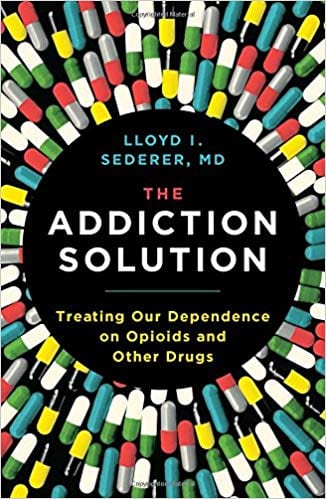This September, www.rtor.org is observing National Recovery Month with a guest blog series on co-occurring disorders – the presence of mental health and substance use disorders in the same person. To kick-off the special series on co-occurring disorders we open with a guest blog post from Lloyd I. Sederer, MD, Chief Medical Officer of the New York Office of Mental Health, the nation’s largest state mental health system. Dr. Sederer is an Adjunct Professor at the Columbia/Mailman School of Public Health and a prolific author, who has written over 500 articles on mental health, culture and politics for TheAtlantic.com, New York Times, Wall Street Journal, NY Daily News, Washington Post.com, Psychology Today, and many other publications. He is also the author of several books, including The Family Guide to Mental Health Care and, most recently, The Addiction Solution: Treating Our Dependence on Opioids and Other Drugs.
Substance use disorders commonly co-occur with mental health conditions. We frequently see alcohol, marijuana and, more recently, opioid use and dependence accompanying serious mental illnesses like depression, bipolar disorder, schizophrenia, eating disorders, as well as PTSD and other forms of trauma.
The co-occurrence of these conditions knows no racial, social, ethnic or geographic boundaries.
I believe that people use substances such as psychoactive (working on the brain and mind) drugs, because they serve them – not all that well or for very long, but their use is the best solution they have come to, so far. Alcohol relaxes social inhibitions and provides a boost of energy (at first). Marijuana (cannabis) is a powerful anxiolytic, reducing nervousness and providing calm and escape from unfortunate circumstances. Sometimes it may be, at first, a social drug – what young people use when together – but then the user discovers its psychic utility. Opioids, the term we use for a variety of morphine-like drugs (including OxyContin, Percodan, Percoset, Fentanyl, Opium and morphine) may well be the most immediately and powerfully effective drugs we have to lessen both physical and psychic pain, to transport hurting people away from the grind and suffering of their everyday lives.
In other words, people with (and without) mental illnesses often turn to drugs and alcohol to quiet their symptoms, because they work, and because they offer pleasure.
But there often is a price to pay. Psychoactive drugs and alcohol can adversely affect our brain transmitters and circuits, inducing mood and thought problems. These drugs may activate an underlying, still quiescent condition, or worsen it. They can also significantly interfere with both the action of psychiatric medications, and a person’s ability to follow the discipline that good treatment requires.
An effective public health and good medical approach to co-occurring conditions involves prevention, detection, early intervention, comprehensive and simultaneous treatment, and staying the course.
Prevention is paramount, of course not for those already affected, but for the legions at risk. And prevention must start with children and teenagers, whose brains are under construction (the process by which the brain develops, called myelinization, is ongoing well into the 20s, longer for males than females).
Proven prevention programs include those that are school-based. They don’t try to scare kids. That never works; in fact it draws their interest. Effective programs teach youth decision-making skills and methods of controlling their moods and impulses. One example is life skills training. Prevention must also extend to the family, using techniques such as “positive parenting,” where parents learn how to be positive, supportive, with their children, to better communicate and to strengthen the family bonds. Big Brother/Big Sister programs—where an older youth of the same background takes on a younger, high-risk child—are also highly protective. These prevention programs work, and we have hardly started to apply them.
Screening for a condition is well known in medical care. Think about blood pressure cuffs, blood sugars and HbA1C, lipid levels, mammograms, and colonoscopies. The sooner a condition, in this case a mental health or substance use disorder, is identified, the sooner we can intervene and prevent it rooting even deeper. We have good screening instruments in mental health, for mood, thought, and functioning. The same applies to substance use disorders. One good example is the Alcohol, Smoking and Substance Involvement Screening Test. Another, for adolescents, is the CRAFFT. Screening for both mental health and substance use disorders needs to become standard practice in schools, pediatric, and family medicine offices.
Families and people affected by co-occurring conditions need to advocate for comprehensive and simultaneous treatment approaches. Comprehensive means not just a reliance on only one form of treatment, like medication, therapy, rehabilitation, or family work. All of them are usually needed, complementing one another, and their effects are additive.
For a substance use disorder, comprehensive treatment includes: Cognitive therapy (CBT) that focuses on reducing the triggers of relapse; 12-Step programs like Alcoholics Anonymous and Narcotics Anonymous; MAT, Medication Assisted Treatment, using buprenorphine (Suboxone) or Vivitrol, sometimes methadone; and family education and support.
Simultaneous treatment means that both the mental health and substance use disorders are treated at the same time, not one before the other, which used to be the rule. No one is apt to get better from either condition unless both are detected and treated simultaneously. It may be very hard to obtain both types of treatment from the same clinic or doctor, but try. Few people already handicapped by their illnesses are willing to go to two different centers.
Finally, with all chronic illnesses, including mental health and substance use disorders, people affected, their families, and their clinicians need to stay the course. People do recover and make lives of relationships, work and contribution, even with illness. We are not good at predicting when, but it happens. So, don’t give up hope – and stay the course.
…….
Want to read The Addiction Solution? Check out the link below!
Your purchases will help support the costs of running rtor.org, a free service of Laurel House, Inc., a 501 (C)(3), nonprofit organization.
Author Bio: Dr. Sederer is a psychiatrist, public health doctor, and medical journalist. His new book is The Addiction Solution: Treating Our Dependence on Opioids and Other Drugs (Scribner, 2018).
The opinions and views expressed in this guest blog do not necessarily reflect those of www.rtor.org or its sponsor, Laurel House, Inc.
Recommended for You
- Veterans and Addiction Recovery: How Families Can Support Their Service Member’s Healing Journey - July 14, 2025
- Trauma-Aware Yoga: A Gentle Path to Healing and Recovery - July 10, 2025
- Why Eating Disorders in Men Are Often Missed - July 3, 2025






Dr. Sederer, thanks for your important piece helping our readers to better understand co-occurring disorders. I believe this is a topic that still needs more understanding and knowledge. I look forward to reading your book.
Anxiety/depression and substance abuse is itself such a common dual diagnosis I often think it should have its own diagnosis. But then I still more of energy trying to convince people we need to formalize adn rigorously describe Developmental Trauma Disorder as its own thing. Thanks for this article. Well done on a topic that’s not discussed enough.